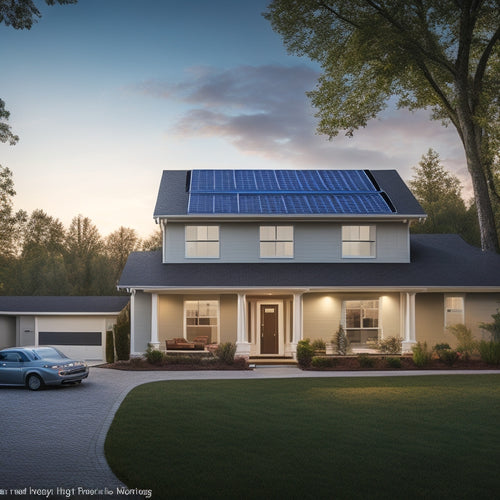
Residential Battery Storage Cost
Share
When considering residential battery storage, your upfront cost will largely depend on the type and size of the battery, with lithium-ion batteries accounting for over 90% of the market share despite being more expensive than alternatives like lead-acid batteries. The cost is influenced by the battery's cycle life, depth of discharge, and inverter compatibility, which impact the system's performance and return on investment. While larger capacity systems entail higher upfront costs, they offer flexibility and can lead to significant savings through time-of-use strategies. As you investigate your options, understanding these factors will be key to maneuvering the complex terrain of residential battery storage.
The Essentials
- Residential battery storage cost is influenced by battery type, with lithium-ion batteries being more expensive but offering longer cycle life and lower maintenance.
- The cost of installation can be offset by utility incentives, rebates, and financing options, making the technology more accessible to homeowners.
- The choice of inverter also affects the overall cost, with high-efficiency inverters minimizing energy losses and maximizing returns on investment.
- Larger storage capacities come with higher upfront costs, but offer more flexibility and energy independence during outages and peak hours.
- The cost of residential battery storage can be justified by the potential to reduce electricity bills by up to 70% through Time of Use (TOU) strategies.
Energy Independence at Night
You're likely familiar with the inconvenience of power outages, but with residential battery storage, you can power through outages and guarantee nighttime energy security.
With a Solar Power Backup system, you can say goodbye to the inconvenience of lost productivity, spoiled food, and compromised safety Reliable Electricity Supply.
When the grid goes down, your stored energy kicks in, providing a reliable source of power even when the sun isn't shining.
Power Through Outages
By leveraging residential battery storage, homeowners can power through outages, ensuring energy independence even at night when the grid is down.
With advanced battery systems, such as solar energy storage, homeowners can effectively store excess energy generated during the day for use during the night or on cloudy days.
You can rest assured that your household remains resilient, even during extended grid outages, by integrating battery storage with your renewable energy system.
This backup solution enables you to conserve energy and manage power effectively, reducing your reliance on the grid.
With residential battery storage, you're prepared for emergency situations, ensuring your family's safety and comfort.
Nighttime Energy Security
As the sun sets, your home's energy demands don't disappear - and neither should your energy independence.
At night, your energy consumption doesn't vanish; it shifts. You still need power to keep your refrigerator running, your lights on, and your security systems active.
With renewable integration, your solar panels or wind turbines may not be producing energy, but your residential battery storage system can fill the gap.
Reduced Peak Hour Charges
When you install a residential battery storage system, you can shift your energy usage from peak hours to off-peak hours, reducing your Time of Use (TOU) charges.
By leveraging affordable solar power storage solutions, you can maximize your solar energy savings. This strategy, known as a Time of Use shift, can greatly lower your electricity bills.
Time of Use Shift
About 70% of homeowners on a Time-of-Use (TOU) rate plan can reduce their peak hour charges by shifting their energy usage to off-peak hours. This strategy, known as Time of Use Shift, allows you to take advantage of lower energy rates during off-peak hours to reduce your overall energy costs. By installing a residential battery storage system, you can store excess energy generated during off-peak hours and use it during peak hours, reducing your reliance on the grid and saving money on your energy bills.
Here's an example of how this works:
| Time | Energy Rate | Strategy |
|---|---|---|
| 10am-3pm | High ($0.30/kWh) | Consume energy from grid |
| 3pm-7pm | High ($0.30/kWh) | Discharge battery to reduce peak usage |
| 7pm-10am | Low ($0.10/kWh) | Charge battery from grid |
Lower Demand Charges
By optimizing your energy usage through Time of Use Shift, you've already taken a significant step towards reducing your energy bills.
Now, let's investigate how residential battery storage can help you lower your demand charges.
Demand response programs, offered by utility companies, incentivize you to reduce your energy consumption during peak hours. By integrating a battery storage system, you can shift your energy usage to off-peak hours, reducing your peak hour charges. This results in significant cost savings.
System integration with your energy management system enables you to monitor and control your energy usage in real-time.
Utility incentives, such as rebates and tax credits, can offset the installation costs of your battery storage system. Additionally, financing options are available to make the change more affordable.
With technology advancements, maintenance requirements are minimal, ensuring a hassle-free experience.
By reducing your reliance on the grid during peak hours, you'll not only save money but also contribute to environmental benefits.
Inverter Compatibility Matters Most
When selecting a residential battery storage system, you'll find that inverter compatibility plays a critical role in determining the overall cost.
The type of battery you choose has a direct impact on the cost, as different chemistries require specific inverter configurations.
For instance, deep cycle batteries off grid battery systems and power backup systems require specialized inverters to guarantee efficient energy storage and retrieval.
Additionally, the efficiency of the inverter itself will affect the system's overall performance and your return on investment.
Battery Type Impacts Cost
You'll find that the type of battery you choose plays a crucial role in determining the overall cost of your residential battery storage system, and inverter compatibility is the key factor driving this cost variance.
When it comes to battery technology, cost analysis reveals that lithium-ion batteries are currently the most popular choice, accounting for over 90% of the market share. However, their installation expenses can be steep, ranging from $400 to $1,200 per kilowatt-hour (kWh).
On the other hand, lead-acid batteries are more budget-friendly, with installation costs ranging from $150 to $300 per kWh.
Maintenance requirements and environmental impact also vary greatly between battery types. Lithium-ion batteries have a longer lifespan and require minimal maintenance, but their production process has a higher carbon footprint.
Lead-acid batteries, on the other hand, have a shorter lifespan and require more frequent maintenance, but their production process is more eco-friendly.
Government incentives and consumer preferences are shifting towards more sustainable options, driving market trends towards lithium-ion batteries.
When considering system integration and warranty options, it's important to weigh the pros and cons of each battery type to guarantee you're getting the best value for your investment.
Inverter Efficiency Matters
Your residential battery storage system's inverter efficiency is a critical factor in determining the overall cost of the system, as it directly impacts the battery's performance and lifespan.
You'll want to select an inverter with high efficiency ratings to minimize energy losses and maximize your investment. Inverter upgrades can greatly improve your system's performance, but they come at an additional cost.
When evaluating inverters, consider their solar integration capabilities, grid interaction, and performance monitoring features. These factors will influence your installation costs, maintenance requirements, and overall system reliability.
As you examine different brands, look for those with a strong focus on technology advancements and competitive warranty options.
Comparing efficiency ratings and warranty terms will help you make an informed decision. Be aware that higher-efficiency inverters often come with higher upfront costs, but they can lead to long-term savings through reduced energy losses.
Depth of Discharge Matters
When you're evaluating residential battery storage options, you'll want to take into account the depth of discharge (DOD) - the percentage of a battery's capacity that's actually used.
For instance, top-rated battery storage systems like Tesla Powerwall often prioritize a lower DOD to guarantee a longer lifespan. A higher DOD can reduce the battery's cycle life, as it increases the wear and tear on the cells.
You'll need to balance the tradeoff between maximizing storage capacity and preserving the battery's lifespan.
Cycle Life Impact
The battery's lifespan is greatly influenced by its cycle life, which is the number of charge and discharge cycles it can handle before its capacity drops below a usable threshold.
As you evaluate residential battery storage, understanding cycle life impact is vital. A longer cycle life means you'll need to replace your battery less often, reducing waste and environmental impact.
It also affects your warranty considerations, as manufacturers often guarantee a certain number of cycles. When calculating installation costs, be sure to factor in the cost of replacement batteries based on their cycle life.
Financing options may also be influenced by the battery's lifespan. As you integrate your battery with the grid, you'll want to take into account how cycle life affects your home automation system.
Additionally, a longer cycle life can increase your home's resale value. With technological advancements driving market trends, it's important to prioritize battery maintenance and select a high-quality battery that meets your needs.
Storage Capacity Effects
Residential battery storage systems require careful consideration of storage capacity effects, as this factor considerably impacts overall performance and cost. When you plan your storage capacity, you're deciding how much energy you want to store and how often you'll use it. This affects your installation costs, maintenance requirements, and warranty considerations.
A larger capacity means higher upfront costs, but it also provides more flexibility and scalability options. However, it may not always be the most efficient choice, as deeper discharges can reduce the battery's lifespan.
You should consider your energy needs and grid integration requirements to determine the best capacity for your system. A deeper depth of discharge (DOD) can increase your energy independence, but it also raises concerns about environmental impact and charging efficiency.
Fortunately, technology advancements and market trends are driving innovation in battery design, allowing for more efficient and sustainable solutions. By carefully evaluating your storage capacity effects, you can create a customized system that meets your energy needs while minimizing costs and environmental impact.
Lithium-Ion Lasts Longer
You'll find that lithium-ion batteries have a markedly longer cycle life compared to other battery chemistries.
On average, they can last for around 5,000 to 7,000 charge cycles, whereas other batteries may only last for 1,000 to 3,000 cycles.
This longer cycle life translates to a longer lifespan, reducing the need for frequent replacements and ultimately saving you money in the long run.
Longer Cycle Life
Several thousand charge and discharge cycles can be expected from a lithium-ion battery, considerably outlasting its lead-acid counterpart. This extended cycle life translates to a significant reduction in maintenance considerations, freeing you from the burden of frequent replacements.
In fact, lithium-ion batteries can last up to 15 years or more, depending on the quality of the cells and how well you maintain them.
When it comes to cycle longevity, lithium-ion batteries stand out from the competition. They can handle up to 5,000 charge cycles, compared to lead-acid batteries which typically max out at around 300 cycles.
This means you'll get more bang for your buck, with lithium-ion batteries providing a longer lifespan and more reliable performance. With fewer replacements needed, you'll save on costs and reduce waste, allowing you to enjoy the freedom and independence that comes with having a reliable energy storage system.
Frequently Asked Questions
Can Residential Battery Storage Systems Be Installed Outdoors?
You can install residential battery storage systems outdoors, but you'll need to guarantee they're weather-resistant and designed for outdoor installation, with features like waterproof enclosures and temperature regulation to withstand environmental stressors.
Are There Government Incentives for Residential Battery Storage?
You might think government incentives are scarce, but you're wrong! You can tap into federal tax credits and state rebates, greatly reducing your investment in residential battery storage, and gaining more freedom from the grid.
Can I Use My Battery Storage System During a Grid Outage?
During a grid outage, you can tap into your battery storage system's backup power, leveraging its capacity to support your energy independence. You'll want to contemplate battery performance, outage duration, and load management to guarantee a seamless shift to backup power.
Do Residential Battery Storage Systems Require Regular Maintenance?
As you access the power of battery storage, you'll want to keep your system running like a well-oiled machine; regular maintenance is key to extending battery lifespan, and you'll typically need to perform checks every 3-6 months to guarantee peak performance.
Can I Monitor My Battery Storage System Remotely?
You can monitor your battery storage system remotely, tracking battery performance in real-time, receiving alerts for potential issues, and optimizing energy usage with data-driven understandings, giving you freedom to manage your energy independence effortlessly.
Final Thoughts
As you stand on the threshold of energy independence, the cost of residential battery storage is the golden key that opens the door. Like Aladdin's magic lamp, it illuminates the path to reduced peak hour charges and a deeper depth of discharge. With inverter compatibility and Lithium-Ion's longer lifespan, the genie of energy savings is released, granting you the power to control your energy destiny. The cost, though significant, is a small price to pay for the freedom to shine bright, even in the darkest of nights.
Related Posts
-

Renewable Energy Solutions to Reduce Your Carbon Footprint
To reduce your carbon footprint, adopting renewable energy solutions is key. Using solar panels or wind turbines can ...
-

Cost of Solar With Battery Backup
You're investing in a solar panel system with battery backup to guarantee reliable power during outages. The cost of ...
-

Essential Hiking Lights for Safety and Fun
When you're hitting the trails, essential hiking lights are vital for safety and fun. A lightweight headlamp offers h...


